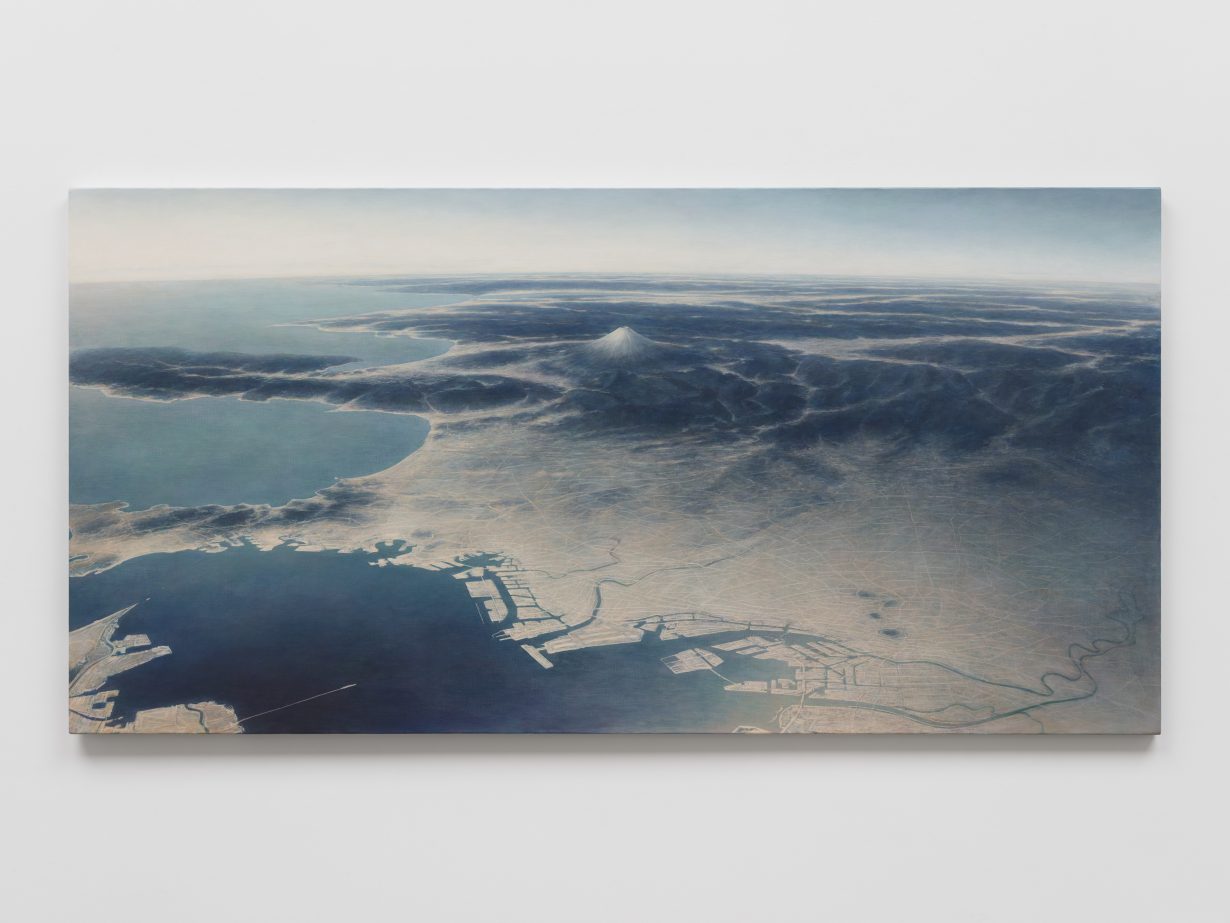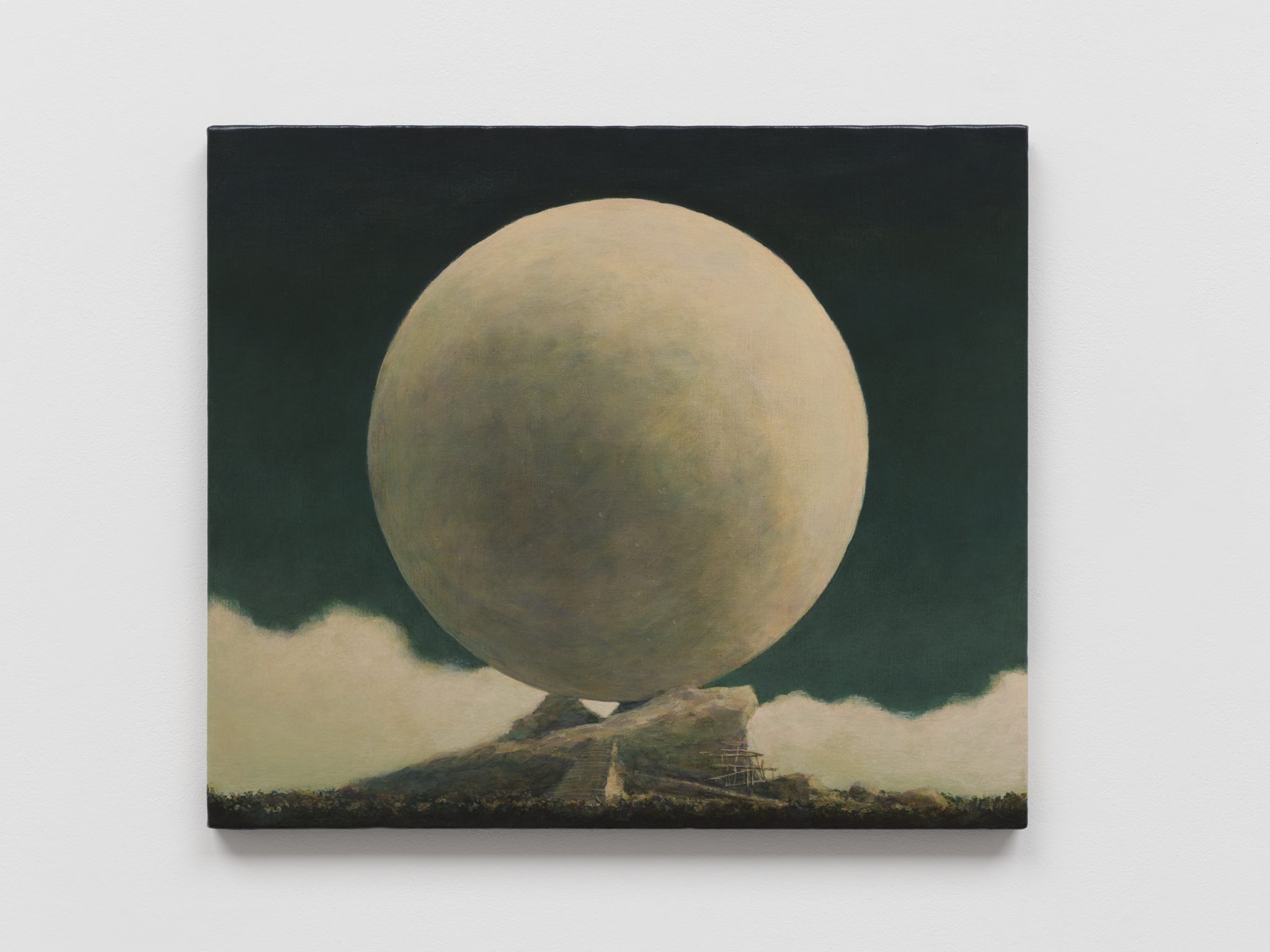Are his paintings allegories for psychological inner-states? Or reflections on societies that aspired to a future that never was?
Although he began painting during the 1980s, Minoru Nomata has only recently started exhibiting outside his native Japan. To style him a painter of ‘fantasy architecture’ would be grossly to undersell the haunting effect of his coldly dreamlike views of sunlit towers, piers, bridges and factories, and other less definable but usually massive structures, often mysteriously fitted with flagstaffs, sails and weather-vanes, all of which stand alone against cool blue skies and restless white clouds. Always empty of people, yet too pristine to be derelict, these architectures sometimes offer indications that they’re not quite finished, as if whoever their makers were had, for whatever reason, simply put down their tools and walked away.
In these recent paintings, mostly from the series Continuum, begun in 2023, Nomura ups the architectural gargantuanism, while also markedly turning away from the building as his main subject. Some of the works are focused on views of vast, verdant landscapes (mountains, ravines, waterfalls), in which we can still pick out the edifices, but which are now small and vulnerable. In the tall, narrow canvas Continuum-4 (2023), for example, a spindly waterwheel is installed at the top of a sheer cliffside, the mechanism harnessing a stream that then plunges to a river far below, a sunlit valley plain stretching towards the horizon. There’s a sense of ecological pessimism, not felt in earlier paintings, in which the possibility of human dwelling has been made precarious due to landscapes that are unforgiving and undomesticated; in Continuum-8 (2024), we see primitive constructions, little more than thatched awnings, sheltering the openings to caves in the side of a high crag. The enigma, here, is the large stone sphere, seen at the end of the gulch: something not formed by nature, but a strangely futile product of labour, if indeed it’s the work of the lowly crag-dwellers.

The huge manmade sphere reappears elsewhere; a gaunt orb, maybe stone, perched atop a low rocky outcrop, access ramps and scaffolds at its base (Continuum-19, 2024). More absurdly, it appears as the below-the-water part of an iceberg, in Continuum-12 (2024) – the painting an impossible vertical visual cut-through that allows us to see above and below the surface of a frigid ocean – as if some odd society took pleasure in shaping these hidden ice-masses, just for fun. For while the natural environment looms over the world of Continuum, those canvases that hold onto Nomata’s more familiar architectural subjects present structures even more whimsical and absurd than previously; a salmon-pink, seven-tiered viewing platform (Continuum-2, 2023), or the stone tower of Continuum-3 (2023), whose only purpose seems to be to provide stairs up to a gantry giving access to an adjacent sculptural column, again with tiered, balustraded platforms; between these span what look like rickety slides, or maybe an outsized ball-run. Either way, there’s a sense that playful futility may have overcome whatever culture built these.

Nomata’s empty world has echoes of artists spanning centuries, of Bruegel’s Tower of Babel paintings, the baroque ruins of Piranesi, the utopian neoclassical visions of Étienne-Louis Boullée or the surrealism of Magritte and M.C. Escher. But these antecedents are harnessed to produce images that are at once allegories for psychological inner-states and a bigger reflection on societies that aspired to a future that might have been, but never was. Here, though, Nomata has added a planetary dimension to his usually hermetic world, and a more tangible intimation of history; of early human societies making their first steps to shape the world to their tastes and needs. And then they are gone: in the thematically standalone Imagine-1 (2018) we see Tokyo Bay from high in the air, the coastal megalopolis rendered as a sand-coloured layer of piers, jetties and road networks, spread across the landscape like a dead coral, while Mount Fuji rises quietly in the distance.
Continuum at White Cube Mason’s Yard, London, 10 July – 24 August
